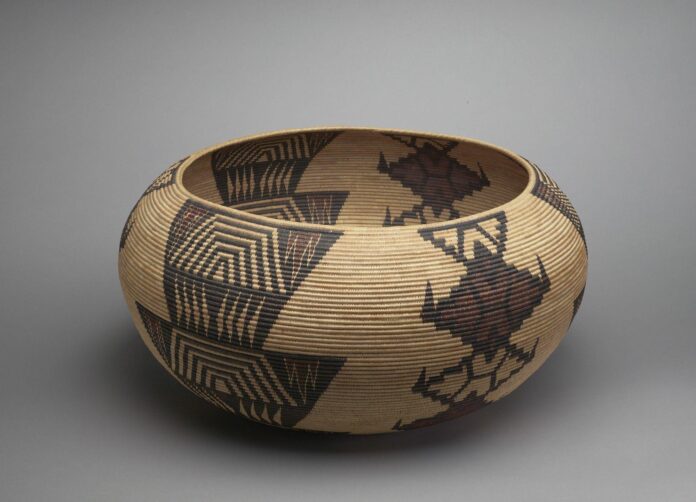Nearly two feet wide, the rotund opo, or basket, boasts a tight weave of willow shoots, roots and redbud carefully configured to form variegated geometric motifs.
The work, crafted in the late 1920s by the Mono Lake Paiute artist Wutoni, won first prize in a 1929 basket-making competition held at Yosemite, and in 2005 set a new auction record for a Native American basket. Now, it has found a home at the Princeton University Art Museum, which has acquired it from a private collector, the institution announced today (15 February).
The basket is of interest to the museum because it has a clearly definable provenance, which is rare for baskets made by Native Americans in the Yosemite. Larger and more complex than those typically produced in the region, it is also an exceptionally well-preserved example of what are known as “fancy baskets”—an elaborate style of weaving developed by Native artists to cater to European Americans.
“This extraordinary work showcases Wutoni’s innovative technique and exceptional command of the medium,” says museum director James Steward. “As we continue to expand our collections to shape more fulsome histories of American art and life, this work makes a potent addition.”
Born in 1869, Wutoni, also known as Tina Charlie, was among the community of Paiute basketmakers from Mono Lake, California, who produced works for non-Native markets influenced by Native traditions but also European needlework and embroidery. She became known in the 1920s as a master craftsperson for developing her own techniques and designs, notably her use of negative and positive space to create dynamic patterns. Like many artists, Wutoni presented her works at Yosemite Indian Field Days, entering competitions for basketry. Organised by the National Park Service, these events were showcases of Native culture that featured craft fairs, rodeos and pageants. While they offered artists opportunities to sell their works, they also perpetuated stereotypes of Native American communities and provided non-Natives with a sanitised, theme park-like experience of Indigenous cultures and practices.
Measuring 10 inches tall and twice as wide, Wutoni’s fancy basket was presented at the 1929 event. It demonstrates the artist’s deft use of tan willow shoots, dyed-black bracken root and the burgundy-coloured branches of redbud trees to delineate intricate motifs. Her weaving, developed in a leftward coiling direction, is dense, showing 18 stitches per inch and five-and-a-half coils per vertical inch.
The basket won top prize at that year’s basketry competition, after which it was purchased directly from Wutoni by Ella Cain, a teacher from Bodie, California. Cain’s parents had owned a store in Nevada and regularly traded goods for baskets made by Mono Lake Paiute; Ella Cain kept many of the best and gradually amassed a large collection, continuing to buy and trade baskets while running her own store in Bridgeport, California.
Wutoni’s basket remained in the Cain family collection until 2005, when it was auctioned at Bonhams in San Francisco. A note by Craig Bates, a former National Park Service curator, described the basket as in “perfect condition; I could only find one bracken fern root stitch missing. It is one of perhaps only ten large baskets of this size ever produced in the Yosemite-Mono Lake Region.” The basket sold for $336,260 (including fees), three times its presale estimate and one of the highest prices ever achieved for a Native American basket at auction.
Since featured in two exhibitions at the Heard Museum of Art—including a display where it was in dialogue with works by David Hockney—the basket will next go on view at the Princeton University Art Museum. But museumgoers will have to wait: the institution’s new building is currently under construction and due to open in late 2024. According to a museum spokesperson, the basket will be “meaningfully contextualised in our pavilion dedicated to American art or in the Native American gallery. It will likely make appearances in each over time.”

























